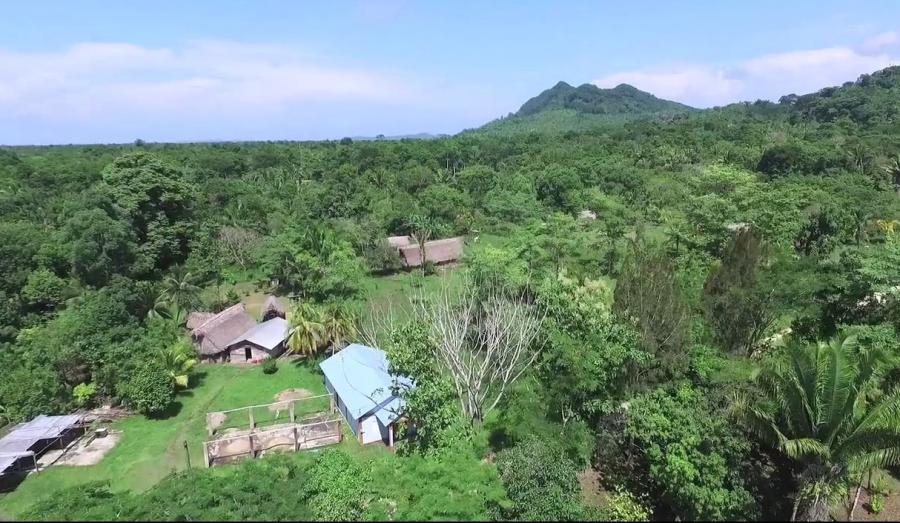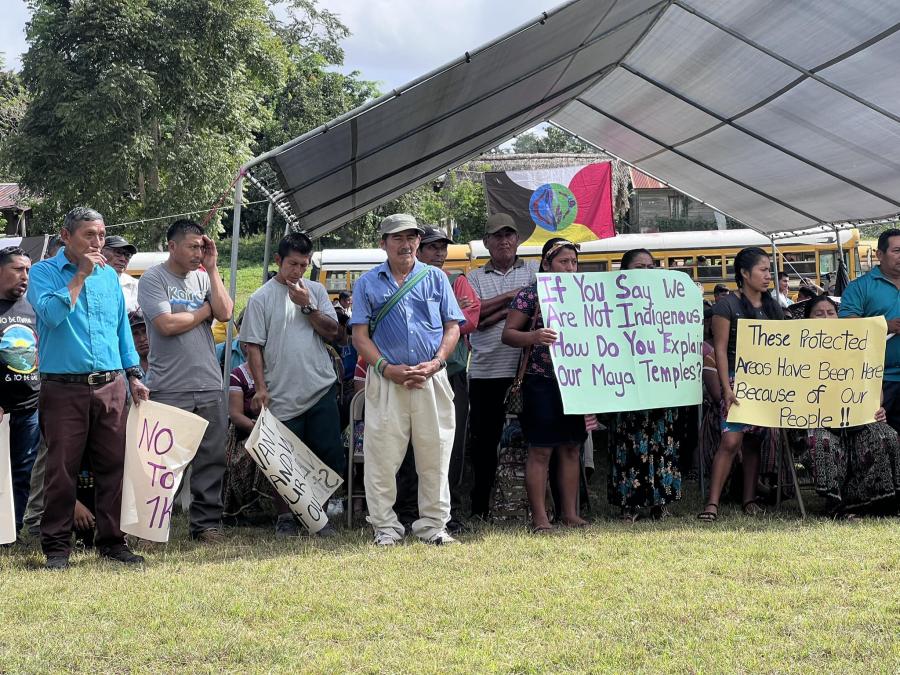The Community Baboon Sanctuary (CBS) located in central Belize, is a community-owned private reserve established to protect a significant black howler monkey population in the area and to promote ecotourism opportunities for resident populations. Today, the CBS encompasses eight villages, a membership of approximately 170 landowners, and roughly 20 square miles of river corridor land. At issue are the growing pains the sanctuary has experienced over its lifetime as well as the sometimes questionable impacts on local residents, particularly in reference to the importance of identifying sustainable strategies for ecotourism development in the area. Management issues, increased competition with other tourism destinations, and greater pressure to distribute economic benefits among surrounding communities, have all resulted in a project that has yet to achieve its aim to reach all landowners committed to the CBS and its purpose. If sound community development is to occur, the approach must prioritize addressing common local needs. If not, the threat of derisive and disruptive consequences looms as local elite players vie for private profits at the expense of community welfare.
Founding Principles of the Community Baboon Sanctuary
In 1985, the Community Baboon Sanctuary (CBS) was established as a private reserve to protect one of the few significant healthy populations of black howler monkeys (alouatta nigra or "baboon" in Creole) in Central America. Since its inception, the CBS has been upheld by the government of Belize as a prime example of a working model of participatory ecotourism development.
Sanctuary membership specifically requires leaving a strip of bush along the river corridor as primary habitat for the howlers; protecting trees along the property fence line in an effort to create an aerial corridor; and preserving food trees for the howlers when clearing farmland. These management practices also benefit landowners by reducing erosion, preventing siltation, and eventually encouraging re-growth after slash and burn clearings. The sanctuary is located in the lowlands of the Belize River in a mixture of riverine, cohune palm and pine forests. While these eight villages were named "Bank" and "Boom" originally, as logging stops on the river, today these lands are privately owned in small parcels and are used for small-scale agriculture and ranching activities.
Initial tourism development efforts in the CBS involved construction of a museum by locals in the most centrally located village, and today the museum remains the focal point of the sanctuary where visitors register and hire local guides. The most common ecotourism activities offered by villagers include canoeing, howler viewing, horseback riding, and bird watching. Rooms in villagers' homes are available for overnight visitors.
While the black howler monkey populations in the sanctuary are thriving, local residents report that ecotourism revenues are primarily benefiting those living in the central village. Critical concerns focus on the extent to which residents understand and support the idea of natural resource conservation; how residents feel about protecting the howlers and their habitat; the extent and nature of membership benefits to locals; and how residents feel about their participation in management of the sanctuary.
Local Residents' Attitudes Towards the CBS
All residents express strong local support for protection of the land -- both to ensure the howlers' habitat and to protect resources for future generations. Residents love the howlers. Most have grown up with howlers all their lives and they know the troops well. Some villagers have followed developments of a particular troop over long periods of time and feel strong emotional bonds with certain individual troop members. New births are discussed with excitement and relocation of adolescents into new troops is duly noted. Most households have howler troops who regularly visit their property. They only jokingly complain about them stealing cashew fruits or mangos; in reality they enjoy seeing them up close and sharing fruit with them. All residents either speak fondly of the howlers or express neutral feelings about their living in such close proximity; no one outwardly expresses negative feelings about them and almost everyone feels their habitat should be protected.
While residents feel strongly about benefits protection of the sanctuary lands has for the howlers, their feelings are much more diverse in reference to how the CBS has impacted them as individuals and their communities. Residents generally acknowledge positive impacts for the community; recognized advantages center on employment opportunities and various ways sanctuary employees have helped villages over recent years (though there is some disagreement on this point). Their understanding has always been that the sanctuary was created for tourism as well as to protect the howlers. Some members do say, however, that the CBS has created new problems and refer to inconsistencies in local management and reported uneven distribution of benefits from tourism-related activities. As a result, residents have mixed feelings about whether their own living conditions have improved since the sanctuary was formed, and many say they lived better, and that it was easier to make a living, before the sanctuary was established.
Many residents feel that sanctuary employees have not helped the communities. There is a mixed history regarding management of the CBS that centers on questions about management capacity and preferences shown for certain tour guides, trail maintenance workers, and local guesthouses. As a result, several years ago residents began to question whether they were adequately represented in the management structure at that time. It was their feeling that certain communities (and households) were benefiting more from sanctuary membership than others. Almost all residents felt the sanctuary was providing jobs to people, though many people acknowledged frustration at the seeming uneven distribution of employment opportunities. As a result of intense questioning over several years, many members who historically supported the sanctuary began to consider withdrawing their membership. And they did so for two reasons -- they questioned whether they were benefiting personally, and they did not feel as if they really "belonged" to the sanctuary as their participation in development planning was rarely requested.
The CBS as a Model for Participatory Ecotourism Development
The history of Third World economic development strategies would suggest that the grassroots foundation of the Community Baboon Sanctuary would support projections of long-term success. While the intent of both the Belize Audubon Society (BAS) and World Wildlife Fund (WWF) in establishing the CBS was to preserve a physical resource to protect the howler monkeys, the conditions under which they invited residents to become members has directly impacted how members now perceive their role in the sanctuary's management as well as their feelings about benefits the sanctuary has had for themselves and their communities.
Membership in the CBS involves a voluntary agreement that requires local residency and local land ownership. When residents became members, they were told they would be able to participate in planning and development activities; they would (and the sanctuary would) equitably distribute all economic benefits resulting from tourism programs; and most importantly, they were encouraged to feel a sense of community ownership of this critical local resource they were now helping to protect. But according to a large proportion of the membership population, these promises have not been kept.
Recent issues with management center on members' lack of participation in planning and development, uneven distribution of economic benefits, and resulting loss of identification with the CBS and its objectives. As the main stakeholders, the general membership feel as if they have little buy-in into any level of responsibility for the on-going direction of the sanctuary and its development of tourism-based activities.
In response to these concerns, and in an effort to provide more equitable representation, the CBS is managed today by an advisory committee of seven members (one representative from each village) overseeing a local manager, all of whom work to ensure that members from all villages are involved in tourism-related activities. Management operates today under the principles of collaboration where stakeholders assume a collective responsibility for problem-solving, decision making and implementation as a means for ensuring that residents are actively participating in discussions pertaining to the nature of ecotourism opportunities that will be supported and developed in their communities.
While many members seem disenchanted with the CBS in general and with its progress, it is interesting to note that all members continue to support the sanctuary, maintaining that 1) the subsistence base of the community has never been threatened (the impacts of restrictions on land use is regarded by most to be negligible), and 2) through the economic benefits derived from increased tourism to the area, the economic status of some individuals, and some households, has improved. A majority of households in the eight villages are members and approximately half of these have pledged lifetime membership. Tourism is overwhelmingly regarded as the most positive benefit of the CBS, and even though membership in the CBS does entail certain restrictions on land and resource use, most residents enjoy the black howler monkeys, have emotional attachments to certain troops, and feel that infrastructure improvements and revenue generated through tourism-related activities clearly outweigh any costs.
In summary, the Community Baboon Sanctuary has the chance to be a sustainable development project. The parts are all in place -- local community ownership of a protected resource, diverse ecotourism possibilities, and economic benefits for local populations. The last key ingredient is local participation. While mistakes have been made over recent years, local community leaders are beginning to listen to residents -- to their discontent, but also to their desire to be involved and to make something of the sanctuary for themselves, their children, and their community. It is this voice that must not only be heard but must become an integral part of how the sanctuary is managed if it is to legitimately serve as a model for participatory ecotourism development.
Suggested Readings
Alderman, C. (1990). A Study of the Role of the Privately-Owned Lands Used for Nature Tourism, Education and Conservation. A Report for Conservation International, Washington DC.
Barry, T. (1995). Inside Belize. Albuquerque, NM: Resource Center Press.
Boo, E. (1990). Ecotourism: The Potentials and Pitfalls, Vols.1&2. Washington DC: World Wildlife Fund.
Horwich, R. H. and Lyon, J. (1990). A Belizean Rain Forest: The Community Baboon Sanctuary. Gay Mills, WI: Orangutan Press.
Ivanko, J. D. (1997). Conservation Meets Community Development. The Rotarian. Oct. 1994: 30-33.
Mahler, R. and Wotkyns, S. (1992). Belize: A Natural Destination. Santa Fe, NM: John Muir Publications.
Place, S. (1995). Ecotourism for Sustainable Development: Oxymoron or Plausible Strategy? Geo Journal. 35:161-173.
Whelan, T., Ed. (1991). Nature Tourism: Managing for the Environment. Washington DC: Island Press.
Article copyright Cultural Survival, Inc.




